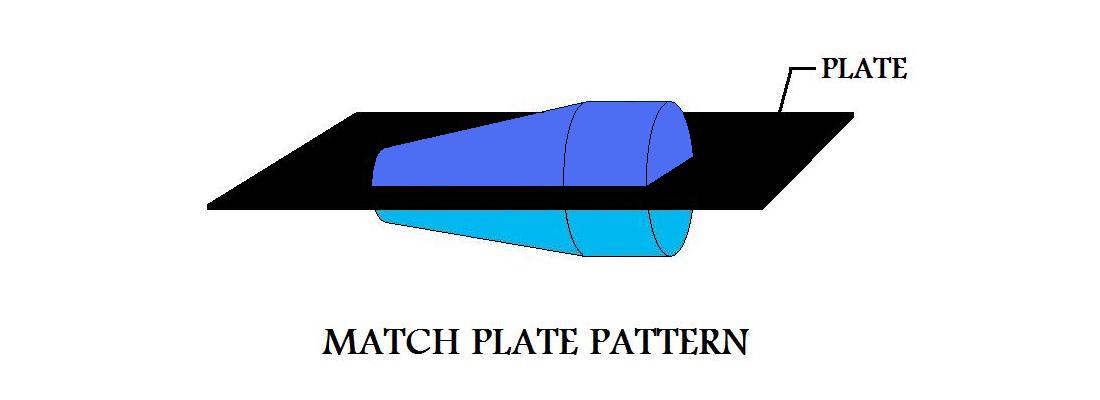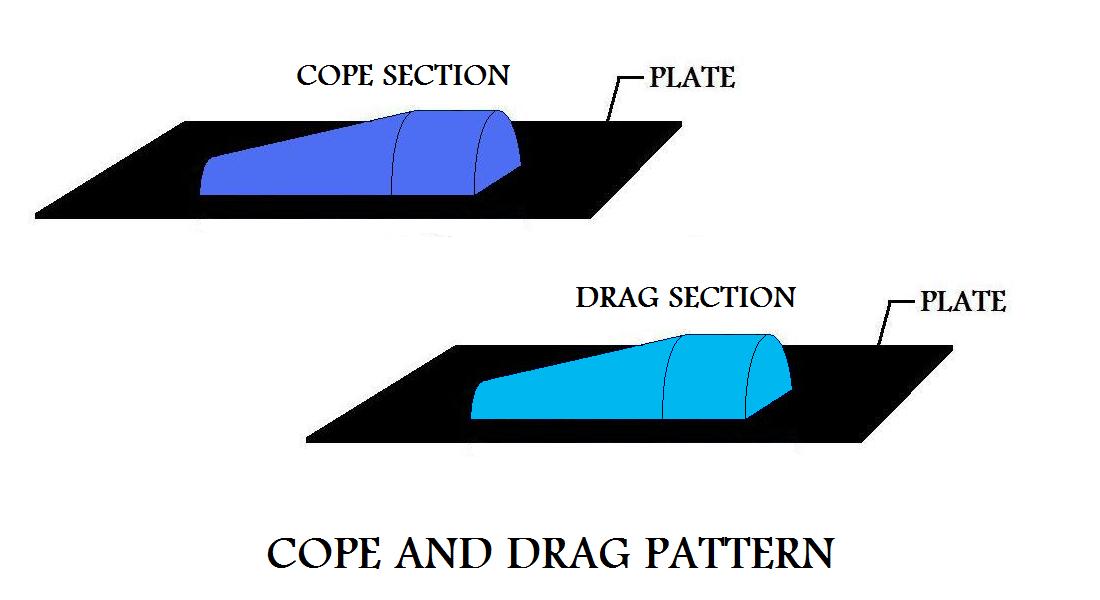METAL CASTING PROCESSES Metal Casting Principles Metal Casting Metal Casting Operation Effect Of Gases On Metal Casting Metal Casting Design Expendable Mold Casting Plaster Mold Casting Ceramic Mold Casting Shell Mold Casting Vacuum Casting or V-process Expanded Polystyrene Casting Investment Casting Permanent Mold Casting Basic Permanent Mold Casting Slush Casting Pressure Casting Vacuum Permanent Mold Casting Die Casting Hot Die Casting Cold Die Casting True Centrifugal Casting Semicentrifugal Casting Centrifuge Casting Ingot Casting Continuous Casting MANUFACTURING PROCESSES Metal Forming Metal Rolling Metal Forging Metal Extrusion Metal Drawing Sheet Metal Powder Processes
Sand Casting
Sand casting is the most widely used metal casting process in manufacturing. Almost all casting metals can be sand cast. Sand castings can range in size from very small to extremely large. Some examples of items manufactured in modern industry by sand casting processes are engine blocks, machine tool bases, cylinder heads, pump housings, and valves, just to name a few.
Sand:
Sand: Product of the disintegration of rocks over long periods of time.Most sand casting operations use silica sand (SiO2). A great advantage of sand in manufacturing applications is that sand is inexpensive. Another advantage of sand to manufacture products by metal casting processes, is that sand is very resistant to elevated temperatures. In fact, sand casting is one of the few processes that can be used for metals with high melting temperatures such as steels, nickel, and titanium. Usually sand used to manufacture a mold for the casting process is held together by a mixture of water and clay. A typical mixture by volume could be 89% sand, 4% water, 7% clay. Control of all aspects of the properties of sand is crucial when manufacturing parts by sand casting, therefore a sand laboratory is usually attached to the foundry.
Use Of Binder In Sand Casting:
A mold must have the physical integrity to keep its shape throughout the casting operation. For this reason, in sand casting, the sand must contain some type of binder that acts to hold the sand particles together. Clay serves an essential purpose in the sand casting manufacturing process, as a binding agent to adhere the molding sand together. In manufacturing industry other agents may be used to bond the molding sand together in place of clay. Organic resins, (such as phenolic resins), and inorganic bonding agents, (such as phosphate and sodium silicate), may also be used to hold the sand together. In addition to sand and bonding agents, the sand mixture to create the metal casting mold will sometimes have other constituents added to it in order to improve mold properties.Types Of Sand Used In Sand Casting:
There are two general types of sand used in the manufacturing process of sand casting. Naturally Bonded- Naturally bonded sand is less expensive but it includes organic impurities that reduce the fusion temperature of the sand mixture for the casting, lower the binding strength, and require a higher moisture content. Synthetic Sand- Synthetic sand is mixed in a manufacturing lab starting with a pure (SiO2) sand base. In this case, the composition can be controlled more accurately, which imparts the casting sand mixture with higher green strength, more permeability, and greater refractory strength. For these reasons, synthetic sand is mostly preferred in sand casting manufacture.Properties Of A Sand Casting Mixture:
Type And Content Of Binder And Other Additives:
As mentioned, controlling the type and content of the sand binder and other additives is the key to controlling the properties of the casting's mold sand mixture.Moisture Content:
Moisture content affects the other properties of the mixture such as strength and permeability. Too much moisture can cause steam bubbles to be entrapped in the metal casting.Grain Size:
This property represents the size of the individual particles of sand.Shape of Grains:
This property evaluates the shape of the individual grains of sand based on how round they are. Less round grains are said to be more irregular.Strength:
The explanation of strength is, the ability of the sand casting mixture to hold its geometric shape under the conditions of mechanical stress imposed during the sand casting process.Permeability:
The ability of the sand mold to permit the escape of air, gases, and steam during the sand casting process.Collapsibility:
The ability of the sand mixture to collapse under force. Collapsibility is a very important property in this type of casting manufacture. Collapsibility of the mold will allow the metal casting to shrink freely during the solidification phase of the process. If the molding sand cannot collapse adequately for the casting's shrinkage, hot tearing or cracking will develop in the casting.Flowability:
The ability of the sand mixture to flow over and fill the sand casting pattern during the impression making phase of the manufacturing process, more flowability is useful for a more detailed casting.Refractory Strength:
During the pouring of the molten metal in sand casting manufacture, the sand mixture in the mold must not melt, burn, crack, or sinter. The refractory strength is the ability of the mold sand mixture to withstand levels of extreme temperature.Reusability:
The ability of the mold sand mixture to be reused to produce other sand castings in subsequent manufacturing operations.When planning the manufacture of a particular casting, remember some properties of a sand casting mold mixture are contradictory to each other. Tradeoffs in different properties are often needed to achieve a compromise that provides a sand casting mold mixture with adequate properties for the specific part and casting application. There are some things to consider when selecting a sand mixture for a manufacturing process. Small grain size enhances mold strength, but large grain size is more permeable. Sand casting molds made from grains of irregular shape tend to be stronger because of grain interlocking, but rounder grains provide a better surface finish. A sand casting mold mixture with more collapsibility has less strength, and a sand casting mixture with more strength has less collapsibility.
Sand Conditioning For A Metal Casting Operation:
If the sand is being reused from a previous sand casting manufacturing process, lumps should be crushed and then all particles and metal granules removed, (a magnetic field may be used to assist in this). All sand and constituents should be screened. In industrial practice shakers, rotary screens, or vibrating screens, are used in this process. Then continuous screw-mixers or mulling machines are used to mix the sand uniformly.Types Of Molds Used In Sand Casting:
Green Sand Molds:
A green sand mold is very typical in sand casting manufacture, it is simple and easy to make, a mixture of sand, clay and water. The term green refers to the fact that the mold will contain moisture during the pouring of the casting.Manufacturing Considerations And Properties Of Green Sand Molds:
- Has sufficient strength for most sand casting applications
- Good collapsibility
- Good permeability
- Good reusability
- Least expensive of the molds used in sand casting manufacturing processes
- Moisture in sand can cause defects in some castings, dependent upon the type of metal used in the sand casting and the geometry of the part to be cast.
Dry Sand Molds:
Dry sand molds are baked in an oven, (at 300F - 650F for 8-48 hours), prior to the sand casting operation, in order to dry the mold. This drying strengthens the mold, and hardens its internal surfaces. Dry sand molds are manufactured using organic binders rather than clay.Manufacturing Considerations And Properties Of Dry Sand Molds:
- Better dimensional accuracy of sand cast part than green sand molds
- Better surface finish of sand cast part than green sand molds
- More expensive manufacturing process than green sand production
- Manufacturing production rate of castings are reduced due to drying time
- Distortion of the mold is greater, (during mold manufacture)
- The metal casting is more susceptible to hot tearing because of the lower collapsibility of the mold
- Dry sand casting is generally limited to the manufacture of medium and large castings
Skin Dried Molds:
When sand casting a part by the skin dried mold process a green sand mold is employed, and its mold cavity surface is dried to a depth of .5 - 1 inch. Drying is a part of the manufacturing process and is accomplished by use of torches, heating lamps or some other means, such as drying it in air.Manufacturing Considerations And Properties Of Skin Dried Molds:
- The cast part dimensional and surface finish advantages of dry sand molds are partially achieved
- No large oven is needed
- Special bonding materials must be added to the sand mixture to strengthen the mold cavity surface
Cold Setting Processes:
In industrial sand casting manufacture, sometimes non-traditional binders other than those used in the above classifications of sand molds may be used. These binders may be made of a variety of things, such as synthetic liquid resins. Conventional casting binders require heat to cure while these when mixed with the sand, bond chemically at room temperature. Hence the term cold setting processes. Technically advanced, these relatively recent sand casting processes are growing in manufacturing. While more expensive than green sand molds, cold setting processes provide good dimensional accuracy of the casting, and have high production applications.Mold Setup For Sand Casting:
The setup of a sand mold in manufacturing involves using a pattern to create an impression of the part to be sand cast within the mold, removal of the pattern, the placement of cores, (if needed), and the creation of a gating system within the mold. The setup of a mold is covered in detail in metal casting process. A mold setup such as the one in Figure 6 could be typical in a sand casting manufacturing operation.The Pattern:
A few different types of patterns may be used in the sand casting process.Solid Pattern:
This is a one piece pattern representing the geometry of the casting. It is an easy pattern to manufacture, but determining the parting line between cope and drag is more difficult for the foundry worker. Figure:23

|
Split Pattern:
The split pattern is comprised of two separate parts that when put together will represent the geometry of the casting. When placed in the mold properly the plane at which the two parts are assembled should coincide with the parting line of the mold. This makes it easier to manufacture a pattern with more complicated geometry. Also mold setup is easier since the patterns placement relative to the parting line of the mold is predetermined. Figure:24

|
Match Plate Pattern:
The match plate pattern is typically used in high production industry runs for sand casting manufacture. A match plate pattern is a two piece pattern representing the casting, divided at the parting line, similar to the split pattern. In the match plate pattern, however, each of the parts are mounted on a plate. The plates come together to assemble the pattern for the sand casting process. The match plate pattern is more proficient and makes alignment of the pattern in the mold quick and accurate. Figure:25

|
Cope and Drag Pattern:
The cope and drag pattern is also typical in sand casting processes for high production industry runs. The cope and drag pattern is the same as the match plate pattern in that it is a two piece pattern representing the casting and divided at the parting line. Each of the two halves are mounted on a plate for easy alignment of the pattern and mold. The difference between the cope and drag pattern and the match plate pattern is that in the match plate pattern the two halves are mounted together, where as in the cope and drag pattern the two halves are separate. The cope and drag pattern enables the cope section of the mold, and the drag section of the mold to be created separately and latter assembled before the pouring of the sand casting. Figure:26

|
In industrial sand casting processes a gating system, (not shown), is often incorporated as part of the pattern, particularly for a cope and drag pattern. Patterns can be made of different materials, and the geometry of the pattern must be adjusted for shrinkage, machine finish, and distortion. Pattern basics are covered in detail in the patterns section.
Cores:
Cores form the internal geometry of the casting. Cores are placed in the mold, and remain there during the pouring phase of the sand casting process. The metal casting will solidify around the core. Core basics are covered in detail in the cores section. Cores are made of the highest quality sand and are subject to extreme conditions during the sand casting operation. Cores must be strong and permeable; also, since the metal casting will shrink onto the core, cores must have sufficient collapsibility. Sometimes a reinforcing material will be placed in a sand casting core to enhance strength. The core may be manufactured with vents to facilitate the removal of gases. Figure:27

|
The Sand Casting Operation:
The sand casting operation involves the pouring of the molten metal into the sand mold, the solidification of the casting within the mold, and the removal of the casting. The casting operation is covered in detail on the metal casting operation page.Of specific interest to sand casting would be; the effect and dissipation of heat through the particular sand mold mixture during the casting's solidification, the effect of the flow of liquid metal on the integrity of the mold, (mold sand mixture properties and binder issues), and the escape of gases through the mixture. Sand usually has the ability to withstand extremely high temperature levels, and generally allows the escape of gases quite well. Manufacturing with sand casting allows the creation of castings with complex geometry. Sand casting manufacture, however, only imparts a fair amount of dimensional accuracy to the cast part.
After the sand casting is removed from the sand mold it is shaken out, all the sand is otherwise removed from the casting, and the gating system is cut off the part. The part may then undergo further manufacturing processes such as heat treatment, machining, and/or metal forming. Inspection is always carried out on the finished part to evaluate the effectiveness and satisfaction of its manufacture.